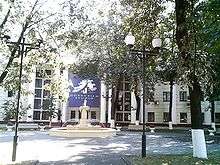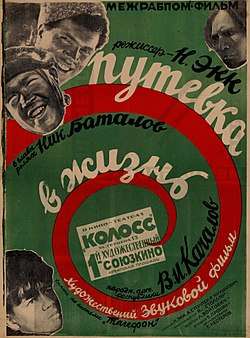Gorky Film Studio
Gorky Film Studio (Russian: Киностудия имени Горького) is a film studio in Moscow, Russian Federation. By the end of the Soviet Union, Gorky Film Studio had produced more than 1,000 films. Many film classics were filmed at the Gorky Film Studio throughout its history and some of these were granted international awards at various film festivals.
 | |
| Corporation | |
| Industry | Motion pictures |
| Predecessor | Soyusdetfilm |
| Founded | 1915 |
| Headquarters | Moscow, Russia |
Key people | Sergey Zernov[1] (General Director) |
| Products | Motion pictures Television programs |
| 29,000,000 (2018) | |
| Website | http://www.gorkyfilm.ru/ |
History
In 1915, Mikhail Semenovich Trofimov, a merchant from Kostroma, established the Rus' film production unit (Russian: "Киноателье «Русь»") with studio facilities. In 1936, the studio was transferred to Butyrskaya Street in Moscow. The Rus' studio, employing many actors from Konstantin Stanislavski's Moscow Art Theatre, specialized in film adaptations of Russian classics (e.g., Tolstoy's Polikushka, 1919).
In 1924, the Rus' studio was renamed into the International Workers Relief agency (Russian: Международная рабочая помощь (Межрабпом)), abbreviated as Mezhrabpom-Rus' (Russian: Межрабпом-Русь). The first Soviet (sci-fi) film, Aelita, was filmed at this studio in 1924.
Four years later, the studio was renamed Mezhrabpomfilm (Russian: Межрабпомфильм), changing its name once again in 1936 to Soyuzdetfilm (Russian: Союздетфильм), the world's first film studio which specialized in films for children. The first soviet sound film, Road to Life, was made there in 1931. Five years later, the first soviet color film, Grunya Kurnakova, followed.
During World War II the film studio was evacuated to Dushanbe and merged with Tadjikfilm. Upon returning to Moscow, the studio was given the name of Maxim Gorky (in 1948). Between 1963 and 2004 its full name was Maxim Gorky Central Film Studio for Children and Youth (Russian: Центральная киностудия детских и юношеских фильмов им. М. Горького).
Since the 1950s, the Gorky Film Studio has been involved into dubbing foreign features. A humorous "film-magazine" for children, Yeralash, has been filmed at this studio since 1975. Until the fall of the Soviet Union, the Gorky Studio had a branch in Yalta. The studio survived the dissolution of the USSR; it is now a private venture.
By the end of the Soviet Union, Gorky Film Studio had produced more than 1,000 films. Many film classics were shot at Gorky Film Studio throughout its history and some of these were granted international awards at various film festivals.
Selected films and TV productions

- 1924 Аэлита / Aelita (silent film), directed by Yakov Protazanov (science-fiction)
- 1926 Мать / Mother (silent film), directed by Vsevolod Pudovkin
- 1927 Конец Санкт-Петергбурга / The End of St. Petersburg (silent film), directed by Vsevolod Pudovkin
- 1931 Путевка в жизнь / Road to Life (first soviet sound film), directed by Nikolai Ekk
- 1934 Восстание рыбаков / Revolt of the Fishermen (drama), directed by Erwin Piscator
- 1936 Груня Корнакова (Соловей-соловушко) / The Nightingale (first soviet color film), directed by Nikolai Ekk
- 1964 Морозко / Jack Frost (fantasy film), directed by Alexander Rou
- 1967 Комиссар / Commissar (drama), directed by Aleksandr Askoldov
- 1973 Семнадцать мгновений весны / Seventeen Moments of Spring (war film), directed by Tatiana Lioznova (TV production)
- 1975 Тайна горного подземелья / The Mystery of the Mountain Dungeon (adventure film), directed by Lev Mirsky
- 1981 Шестой / The Sixth One (ostern), directed by Samvel Gasparov
- 1984 Медный ангел / Copper Angel, directed by Veniamyn Dorman
- 1985 Гостья из будущего / Guest from the Future (science-fiction), directed by Pavel Arsenov (TV production)
- 1988 Маленькая Вера / Little Vera (drama), directed by Vasili Pichul
- 1989 Подземелье ведьм / The Witches Cave (science-fiction), directed by Yuri Moroz
- 1989 Князь Удача Андреевич/ Prince Luck Andreevich (Mystery), directed by Gennadi Baisak
- 1999 Восемь с половиной долларов / 8 ½ $ (crime, comedy), directed by Grigori Konstantinopolsky
- 2004 Арье / Arie (drama), directed by Roman Kachanov
- 2013 Вий: Возвращение / Viy. Returning (drama, history, horror), directed by Oleg Stepachenko
References
- "Official site of Gorky Film Studio". Archived from the original on 2014-08-08. Retrieved 2014-08-03.